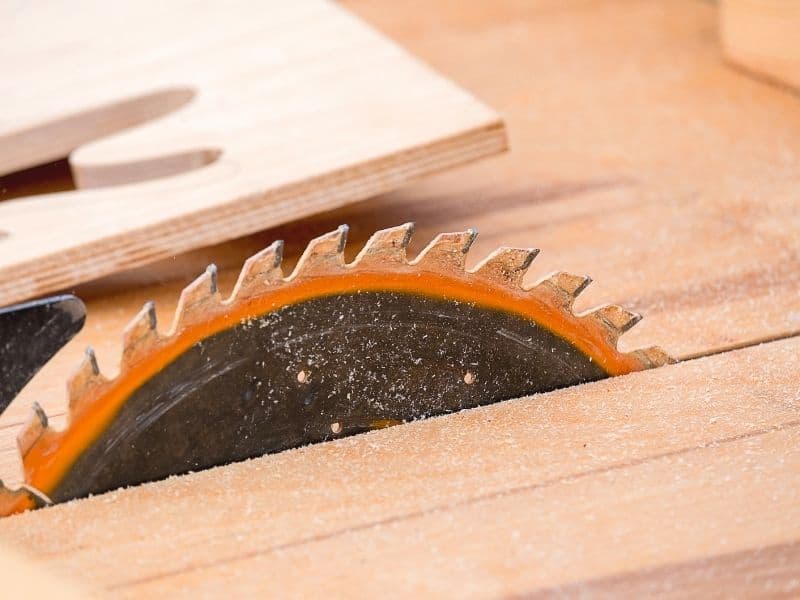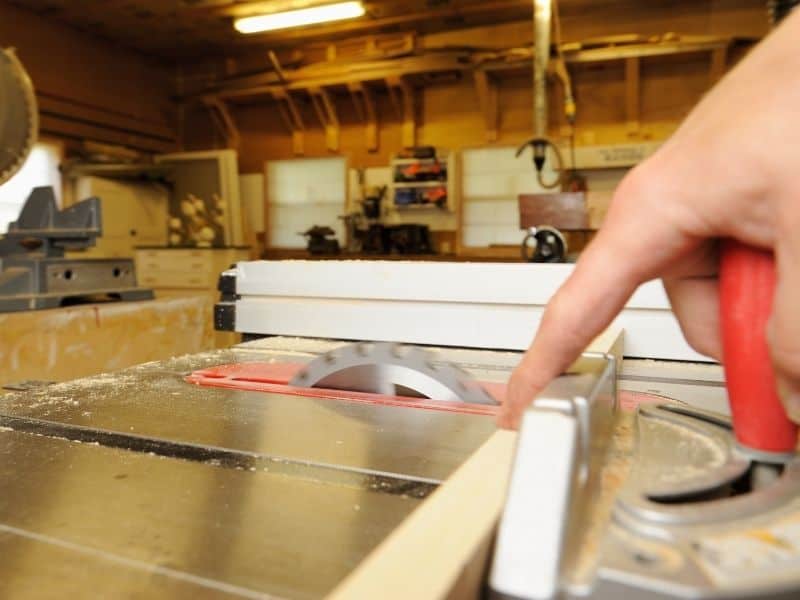
If you have experienced the frustration of burn marks when using your table saw, you are not alone. It is a common problem, that many woodworkers deal with at some point. I decided to do some research and check out what exactly causes these issues and what you can do about it. So what is the leading cause of burn marks on wood when using a table saw?
Burn marks appearing on wood that was cut with a table saw are caused by excessive friction which results in a high generation of heat. This excessive buildup of heat can result in burnt or scorched wood. There are several reasons why this may happen, some of the most common are:
- Improper feed rate
- Dull saw blade
- Dirty saw blade
- Incorrect saw blade
- Poor alignment
Each of these items is relatively easy to fix, you just have to know what to look out for when trying to identify the problem. In the next sections, we will take a look at what you should be looking for as well as what you should do to fix the problem.
If you want to skip all the reading and jump straight into our quick reference guide, click here and it will take you to the bottom of the page for an easy-to-follow troubleshooting guide.
1. Improper feed rate causing excessive heat buildup on the wood
One of the common scenarios that cause burning when cutting wood with a table saw is feeding the wood through the table saw too slowly. If the blade spends too much time in one spot, it will cause excessive heat which will scorch your lumber.
So how fast should you push the wood through the table saw? Well, unfortunately, there is not a great answer here. It depends on the thickness of the material, how many teeth your blade has, how sharp your blade is, and even on the species of wood you are using.
If you notice you may be feeding the wood too slowly, try and experiment with different feed rates. The best way to learn is to practice and get a feel for what works in your situation.
Also, pay attention to if you are stopping the workpiece at any point to reposition. This can cause burns in those areas. If you have to reposition to continue feeding safely, then it’s a better option to have some burn marks than to have a dangerous situation. With the use of push blocks, you can tend to eliminate or at least minimize the stoppage safely.
2. Dull table saw blade won’t cut properly
If you think feed rate might be your problem, but the blade just won’t cut fast enough, it could be due to a dull blade.
A dull blade will not be nearly as efficient as a sharp blade. This will severely inhibit your ability to push the wood stock through the blade at the proper feed rate.
If you think a dull blade might be the issue, you can check out my other article here, where we discuss things to look for to determine if you need to replace your table saw blade or maybe have it professionally sharpened.
3. Too many teeth can prevent material removal

Depending on the type of blade you are using, it could be causing burning or scorching of the wood. A blade with a lot of teeth; 60 or more, will only remove small bits of wood at a time in comparison to a blade with fewer teeth. This means it will take longer to make your cuts if you have too many teeth on your table saw blade.
When ripping a board, you can use a fairly small number of teeth to speed up the process and yield some pretty good results.
There is another article I wrote which you can find here, that discusses the different blade types and when you should each one. It is a good read to help familiarize yourself with the different types of blades, or if you just need to brush up on the different blade types for a table saw.
3. Dirty Saw blade performs similarly to a dull table saw blade

A dirty saw blade can cause you to think you have a dull saw blade, mainly because the symptoms are very similar.
A dirty saw blade will cause all the same effects as if you were trying to cut with a dull saw blade. It can cause poor cuts, and slow feeds resulting in burn marks on your lumber.
However, don’t fret. This one is an easy fix. Just remove the blade and give it a good cleaning to restore it to an acceptable level. In another article, I have a section that talks about this a bit more, and you can find that here.
5. Incorrect fence and blade alignment can cause binding

Another issue that can cause burn marks on your wood, is incorrect fence and blade alignment. This should be a bit more cause for concern if this is the issue you are having. Not only will this cause burn marks but it can cause a dangerous kickback scenario and should be fixed ASAP.
If your fence and blade are not parallel to each other, it can cause the wood to begin pushing into the side of the blade as it is spinning, putting it into a bind. This builds up a lot of heat and causes burning.
Wood in a bind on a spinning table saw blade is a recipe for disaster and should be dealt with before continuing any more cutting. If the wood gets in too much of a bind, the blade will overpower the force you are using to push it through and send it hurdling back at you.
In another article, I go into depth on the process of checking different alignment aspects of your table saw. If you are worried about your table saw alignment, give this section a quick read here.
Troubleshooting Guide
Use the quick reference table below to help you go through the most common scenarios you may be dealing with on your table saw. Feel free to bookmark this page so you can come back to it later.
| Possible Cause | Symptoms | Solution |
|---|---|---|
| Improper Feed Rate | Burn Marks or Scorching When Pushing More Slowly | Vary Feed Rate Until Burns Stop Appearing. Will Vary Depending on Saw and Material |
| Dull Saw Blade | Chipping, Tearing, Bent or Damaged Teeth | Replace Blade |
| Dirty Saw Blade | Tree Sap or Glue Residue Buildup On Teeth | Clean Blade with Proper Cleaner |
| Incorrect Saw Blade | Difficult to Feed Wood During Rip Cuts, Tear-out When Cross-cutting | Use a Blade with Less Than 60 Teeth for Ripping, Use a Blade with More Than 40 Teeth for Cross-cuts |
| Poor Alignment | Wood Binds Mid-cut, Cuts Aren’t Straight, Kickback Occurs | Use Square To Ensure Correct Blade and Fence Alignment |
Final Thoughts
If you are getting burn marks or scorched areas on your wood while using your table saw, it can be quite frustrating. Some of the common causes are a slow feed rate, a dull saw blade, a dirty saw blade, blade and fence alignment, and a saw blade with too many teeth.
Review some of the other articles that I have linked to in this article to help nail down what is actually happening. Once you find the problem, you will be able to focus on a solution and hopefully get clean, non-burned, crisp cuts.


